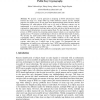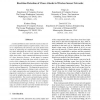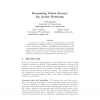38 search results - page 5 / 8 » Preserving Privacy in Social Networks Against Neighborhood A... |
JUCS
2008
13 years 7 months ago
2008
: In a secure roaming scenario, a user U travels to a foreign network and communicates with a foreign server V securely so that no one other than U and V can obtain the messages ex...
NETWORKING
2007
13 years 9 months ago
2007
We propose a novel approach in designing an RFID infrastructure which foresees the usage of a single RFID tag within different contexts and for multiple purposes. We regard privacy...
EDBT
2010
ACM
13 years 11 months ago
2010
ACM
With more and more social network data being released, protecting the sensitive information within social networks from leakage has become an important concern of publishers. Adve...
ICDCS
2008
IEEE
14 years 2 months ago
2008
IEEE
A central problem in sensor network security is that sensors are susceptible to physical capture attacks. Once a sensor is compromised, the adversary can easily launch clone attac...
CSFW
2000
IEEE
14 years 4 days ago
2000
IEEE
In this paper we develop a language of mobile agents called uPLAN for describing the capabilities of active (programmable) networks. We use a formal semantics for uPLAN to demonst...



